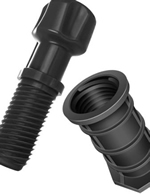Company engineers recently investigated published industry standards for shear values of threaded lift pins with socket when embedded in concrete of 3,500 psi or higher compressive strength.
Skeptical of some ratings, Meadow Burke Vice President of Engineering Mike Recker timed testing while developing the company’s new Threaded Lifting Pin with Socket product. “We feel the published performance, safe working load values are based on purely testing in mechanical means, shearing the pin itself, not by the proper means of evaluating with the concrete surrounding it,” he says. “Meadow Burke prefers to test lifting products within concrete to the point of failure, ideally [through] an independent lab. Casting the device in concrete is the only way to establish true safe working load performance.”
Partnering with Georgia-based Applied Technical Services, the manufacturer tested its Threaded Lift Pin product to the point where it bent and/or crushed the concrete—disengaging the hook from the pin, thus ultimately failing. The results showed a lower safe working load capacity than what was previously published by the industry. From testing based on dead load in shear only on a specimen of 3,500 psi compressive strength with 5-in. minimum thickness and 12-in. minimum edge distance, the Threaded Lifting Pin with Socket exhibits these performance and specifications: allowable shear load SF 4:1, 2,000 lb.; ultimate tested load in concrete, 8,000; and, ultimate mechanical shear load, 20,000 lb.
“Meadow Burke has a duty to establish a true standard of testing and bring awareness so products in the industry are clearly represented with their safe working loads in order to help customers make decisions of what a product can or cannot lift,” Recker contends. — Meadow Burke LLC, 877/518-7665
